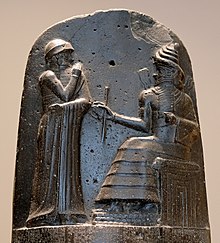1790s BC
Going by the middle chronology, the Babylonian Empire saw the death of its king, Sin-Muballit in c. 1792 BC.Shamshi-Adad I, king of Assyria, continued his conquests, defeating Yahdun-Lim of Mari.The Cemetery H culture had developed by this time in northern India: distinguishing features of this culture include the use of cremation of human remains, reddish pottery, apparent breakdown of widespread trade, and rice farming.Manning (2008) tentatively estimates the world population in 1799 BC as 85 million.c. 1792 BC: Work begins on the Stela of Hammurabi (now in the Louvre, Paris).
HammurabiMillennium2nd millennium BCCenturies19th century BC18th century BC17th century BCDecades1810s BC1800s BC1780s BC1770s BCNear EastMiddle Bronze Agemiddle chronologyBabylonian EmpireSin-MuballitCode of Hammurabiancient Near EastShamshi-Adad IAssyriaYahdun-LimMiddle Kingdom of EgyptThirteenth DynastySonbefSekhemkareAmeny QemauHotepibreCemetery H culturecremationXia DynastyJin of XiaBabylonStela of HammurabiLouvreRim-Sin ISumu-EpuhYamhadAmoritePharaoh of EgyptNerikareShort Chronology
